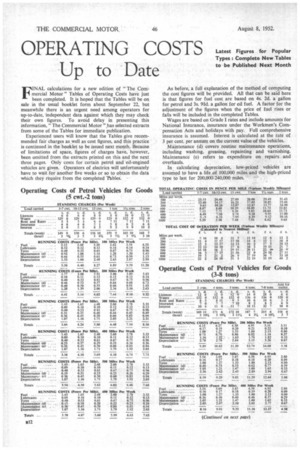F INAL calculations for a new edition of "The Commercial Motor"
Page 46

If you've noticed an error in this article please click here to report it so we can fix it.
Tables of Operating Costs have just been completed. It is hoped that the Tables will be on sale in the usual booklet form about September 22, but meanwhile there is an urgent need among operators for up-to-date, independent data against which they may check their own figures. To avoid delay in presenting this information, "The Commercial Motor "has selected extracts from some of the Tables for immediate publication.
Experienced users will know that the Tables give recommended fair charges as well as cost figures, and this practice is continued in the booklet to be issued next month. Because of limitations of space, figures of charges have, however, been omitted from the extracts printed on this and the next three pages. Only costs for certain petrol and oil-engined vehicles are given. Operators of electrics will unfortunately have to wait for another five weeks or so to obtain the data which they require from the completed Tables. As before, a full explanation of the method of computing the cost figures will be provided. All that can be said here is that figures for fuel cost are based on 4s. 2d. a gallon for petrol and 3s. 9td. a gallon for oil fuel. A factor for the adjustment of the figures when the price of fuel rises or falls will be included in the completed Tables.
Wages are based on Grade I rates and include amounts for National Insurance, insurance under the Workmen's Compensation Acts and holidays with pay. Full comprehensive insurance is assumed. Interest is calculated at the rate of 3 per cent. per annum on the current value of the vehicles.
Maintenance (d) covers routine maintenance operations, including washing, greasing, repainting and varnishing. Maintenance (e) refers to expenditure on repairs and overhauls.
In calculating depreciation, low-priced vehicles are assumed to have a life of 100,000 miles and the high-priced type to last for 200,000-240,000 miles.




















































































